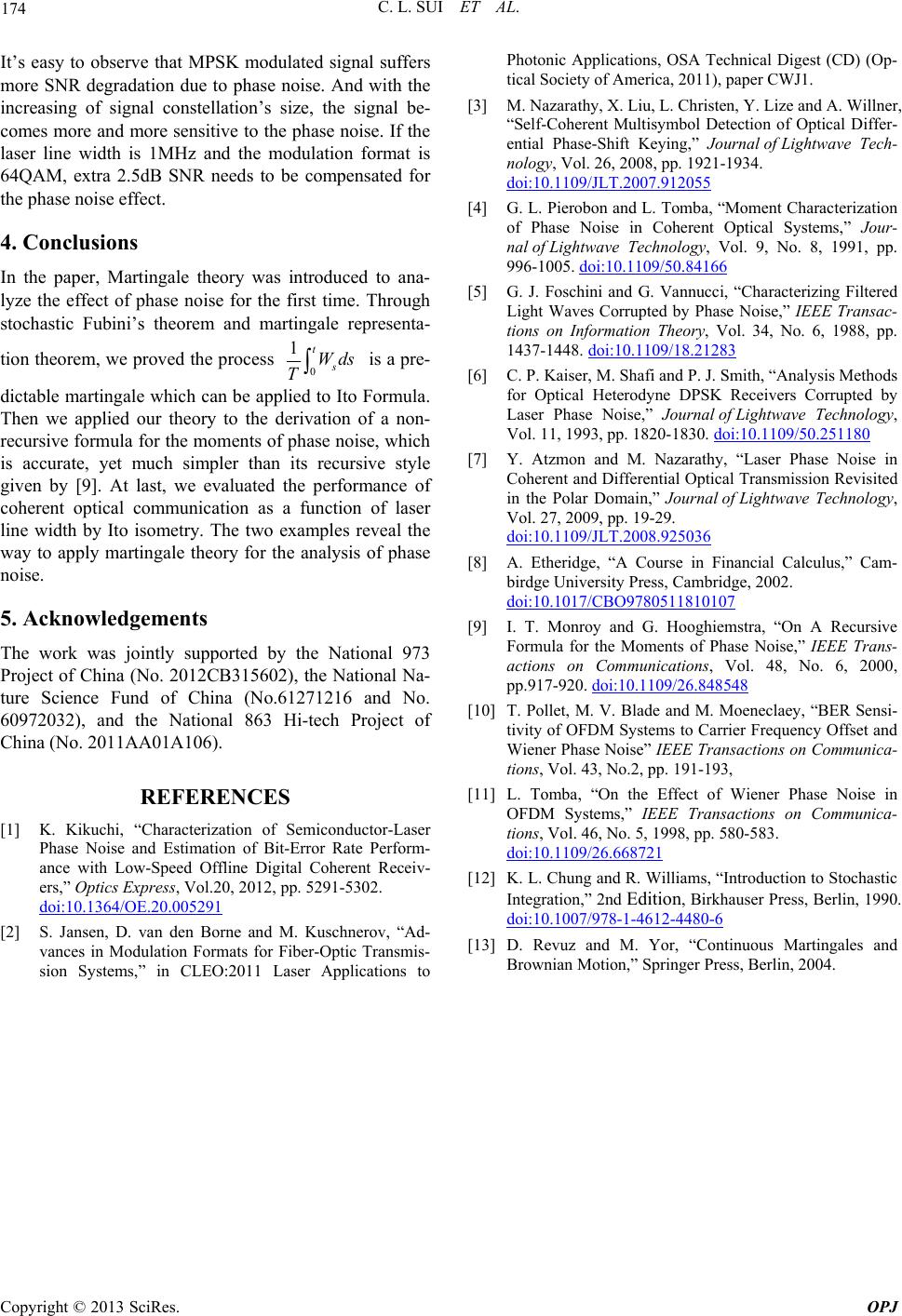
C. L. SUI ET AL.
Copyright © 2013 SciRes. OPJ
174
It
4. Conclusions
ngale theory was introduced to ana-
’s easy to observe that MPSK modulated signal suffers
more SNR degradation due to phase noise. And with the
increasing of signal constellation’s size, the signal be-
comes more and more sensitive to the phase noise. If the
laser line width is 1MHz and the modulation format is
64QAM, extra 2.5dB SNR needs to be compensated for
the phase noise effect.
In the paper, Marti
lyze the effect of phase noise for the first time. Through
stochastic Fubini’s theorem and martingale representa-
tion theorem, we proved the process 0
1tWds is a pre-
s
T
dictable martingale which can be applied to Ito Form
5. Acknowledgements
orted by the Nationa
REFERENCES
[1] K. Kikuchi, miconductor-
ula.
Then we applied our theory to the derivation of a non-
recursive formula for the moments of phase noise, which
is accurate, yet much simpler than its recursive style
given by [9]. At last, we evaluated the performance of
coherent optical communication as a function of laser
line width by Ito isometry. The two examples reveal the
way to apply martingale theory for the analysis of phase
noise.
The work was jointly suppl 973
Project of China (No. 2012CB315602), the National Na-
ture Science Fund of China (No.61271216 and No.
60972032), and the National 863 Hi-tech Project of
China (No. 2011AA01A106).
“Characterization of SeLaser
Phase Noise and Estimation of Bit-Error Rate Perform-
ance with Low-Speed Offline Digital Coherent Receiv-
ers,” Optics Express, Vol.20, 2012, pp. 5291-5302.
doi:10.1364/OE.20.005291
[2] S. Jansen, D. van den Borne and M. Kuschnerov, “Ad-
A. Willner,
vances in Modulation Formats for Fiber-Optic Transmis-
sion Systems,” in CLEO:2011 Laser Applications to
Photonic Applications, OSA Technical Digest (CD) (Op-
tical Society of America, 2011), paper CWJ1.
[3] M. Nazarathy, X. Liu, L. Christen, Y. Lize and
“Self-Coherent Multisymbol Detection of Optical Differ-
ential Phase-Shift Keying,” Journal of Lightwave Tech-
nology, Vol. 26, 2008, pp. 1921-1934.
doi:10.1109/JLT.2007.912055
[4] G. L. Pierobon and L. Tomba, “Moment Characterization
of Phase Noise in Coherent Optical Systems,” Jour-
nal of Lightwave Technology, Vol. 9, No. 8, 1991, pp.
996-1005. doi:10.1109/50.84166
[5] G. J. Foschini and G. Vannucci, “Characterizing Filtered
Light Waves Corrupted by Phase Noise,” IEEE Transac-
tions on Information Theory, Vol. 34, No. 6, 1988, pp.
1437-1448. doi:10.1109/18.21283
[6] C. P. Kaiser, M. Shafi and P. J. Smith, “Analysis Methods
for Optical Heterodyne DPSK Receivers Corrupted by
Laser Phase Noise,” Journal of Lightwave Technology,
Vol. 11, 1993, pp. 1820-1830. doi:10.1109/50.251180
[7] Y. Atzmon and M. Nazarathy, “Laser Phase Noise in
036
Coherent and Differential Optical Transmission Revisited
in the Polar Domain,” Journal of Lightwave Technology,
Vol. 27, 2009, pp. 19-29.
doi:10.1109/JLT.2008.925
inancial Calculus,” Cam-[8] A. Etheridge, “A Course in F
birdge University Press, Cambridge, 2002.
doi:10.1017/CBO9780511810107
[9] I. T. Monroy and G. Hooghiemstra, “On A Recursive
Formula for the Moments of Phase Noise,” IEEE Trans-
actions on Communications, Vol. 48, No. 6, 2000,
pp.917-920. doi:10.1109/26.848548
[10] T. Pollet, M. V. Blade and M. Moeneclaey, “BER Sensi-
iener Phase Noise in
tivity of OFDM Systems to Carrier Frequency Offset and
Wiener Phase Noise” IEEE Transactions on Communica-
tions, Vol. 43, No.2, pp. 191-193,
[11] L. Tomba, “On the Effect of W
OFDM Systems,” IEEE Transactions on Communica-
tions, Vol. 46, No. 5, 1998, pp. 580-583.
doi:10.1109/26.668721
[12] K. L. Chung and R. Williams, “Introduction to Stochastic
Integration,” 2nd Edition, Birkhauser Press, Berlin, 1990.
doi:10.1007/978-1-4612-4480-6
[13] D. Revuz and M. Yor, “Continuous Martingales and
Brownian Motion,” Springer Press, Berlin, 2004.